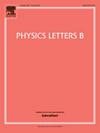Multi-messenger probes of asteroid mass primordial black holes: Superradiance spectroscopy, Hawking radiation, and microlensing
IF 4.3
2区 物理与天体物理
Q1 ASTRONOMY & ASTROPHYSICS
引用次数: 0
Abstract
Superradiance provides a unique opportunity for investigating dark sectors as well as primordial black holes, which themselves are candidates for dark matter over a wide mass range. Using axion-like particles as an example, we show that line signals emerging from a superradiated axion cloud combined with black hole Hawking radiation in extragalactic and galactic halos, along with microlensing observations lead to complementary constraints on parameter space combinations including the axion-photon coupling, axion mass, black hole mass, and its dark matter fraction, . For the asteroid mass range , where primordial black holes can provide the totality of dark matter, we demonstrate that ongoing and upcoming observations such as SXI, JWST, and AMEGO-X will be sensitive to possible line and continuum signals, respectively, providing probes of previously inaccessible regions of parameter space. Further complementarity from a stochastic gravitational-wave background emerging from the black hole formation mechanism is also considered.
求助全文
约1分钟内获得全文
求助全文
来源期刊

Physics Letters B
物理-物理:综合
CiteScore
9.10
自引率
6.80%
发文量
647
审稿时长
3 months
期刊介绍:
Physics Letters B ensures the rapid publication of important new results in particle physics, nuclear physics and cosmology. Specialized editors are responsible for contributions in experimental nuclear physics, theoretical nuclear physics, experimental high-energy physics, theoretical high-energy physics, and astrophysics.
 求助内容:
求助内容: 应助结果提醒方式:
应助结果提醒方式:


